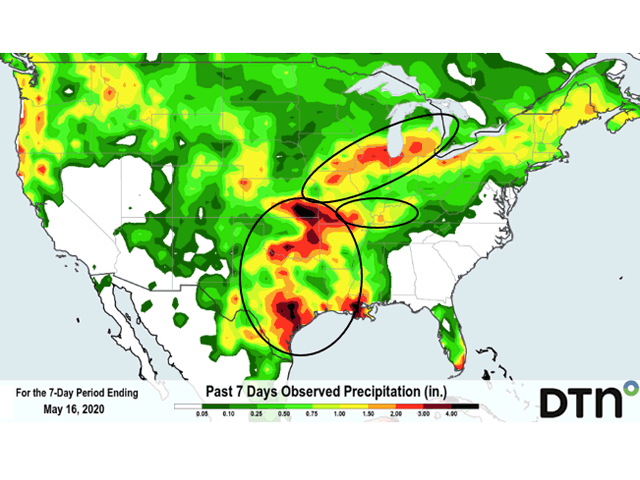Ag Weather Forum
Weekend Rain Recap
The post-Mother's Day week turned out to be a very wet period in the Midwest, notably during the Friday, May 15, through Sunday, May 17, stretch in the eastern Midwest. Rainfall of 1 inch to 2.5 inches with locally 3-plus inches was noted from eastern Missouri through central and northeastern Illinois. That included a four-day rainfall total of a reported 7.88 inches -- almost 8 inches -- in the Chicago area. The rain is noted continuing into the remainder of the eastern Midwest during the first part of this week. Flooding and severe storm potential are part of the scene as well.
In the Western Corn Belt, much of Iowa recorded amounts of 0.50 inch to 1.50 inches and locally heavier. More than 2 inches was logged at some stations in northwest and north-central Iowa. Lighter rain was noted in the western one-fourth of the state.
A large portion of the Southern Plains shared in the rain, even exceeding the Midwest totals. Rain totals exceeding 5 inches were noted in southeastern Kansas along with the Texas-Louisiana Gulf Coast.
P[L1] D[0x0] M[300x250] OOP[F] ADUNIT[] T[]
The heavy rain totals are reminiscent of the very wet year of 2019. Just one year ago we saw a similar rainfall eruption in the central U.S. That outbreak was then followed by continued very heavy rain well into the early summer as planting disruptions led to more than 20 million acres claimed as prevented planting acres. Circumstances in 2020 are different, with much more favorable fieldwork and planting -- along with producer aggressiveness -- combining to bring on planting rates that are far ahead of a year ago and even well ahead of average.
The impact from the rain also is a reminder of 2019. Northern Plains spring wheat acreage is already in question due to wet soils and continued periods of rain and snow hindering progress. But eastern Midwest producers, after generally more favorable conditions in the 2020 spring, had a reminder of how the rain tendency in the Midwest is to a more frequent occurrence of heavy totals.
For more details on the effect of the rain, I checked with Dennis Todey, director of the USDA Midwest Climate Hub in Ames, Iowa. His reply spoke to the variability of rainfall impact.
"Well, the reaction depends on location," Todey said. "Recent rains have been quite beneficial on some very dry soils from the central Plains into Iowa. The dryness had really allowed for quick planting work. But now many soil surfaces needed an inch or so of rain to wet the near-surface soils again and make sure newly planted seeds had enough moisture to begin growing well. Comments from Iowa agronomists indicated they expected quick growth and green-up with warmer temperatures coming."
Todey also noted the adverse effect of the heavy amounts in the eastern Midwest. "Parts of the rains were very excessive in Illinois where we could end up with some replants according to comments from the Illinois State Climatologist," he said.
Rain continues in the forecast going into the final week of May across much of the central U.S. Rainfalls of 0.5 inch to 1.5 inches, locally heavier, are indicated for the northern through south-central Plains and most of the Midwest. Very heavy totals of more than 3 inches are likely in the Ohio Valley and the Tennessee Valley areas. With this kind of rain forecast, soil moisture will likely remain adequate to surplus for crop areas that are not flooded. But it's not out of the question that there will still be some disruptions with planting the final round of row crops -- not to mention acreage questions in general in the northern tier.
Bryce Anderson can be reached at Bryce.anderson@dtn.com
Follow him on Twitter @BAndersonDTN
(c) Copyright 2020 DTN, LLC. All rights reserved.




